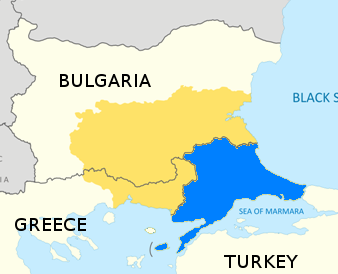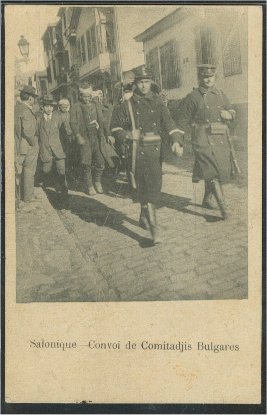|
Vasil Chekalarov
Vasil Hristov Chekalarov ( Bulgarian/) or Vasil Tcakalarov (1874 – 9 July 1913) was a Bulgarian revolutionary and one of the leaders of Internal Macedonian-Adrianople Revolutionary Organisation in Macedonia. H. N. Brailsford described Chekalarov as the "cruel but competent general" of the Southern insurgents in Macedonia. He considered the adherents of Macedonist ideas to be Grecomans. He was a leading '' komitaji'' in the bands of the Bulgarian Macedonian-Adrianople Revolutionary Committees and took part in the battles against the Ottoman authorities as well before the Ilinden Uprising as after it. In 1901-1902 he created a channel for illegal purchase and transfer of firearms from Greece to Southern Macedonia. In May 1903, Chekalarov participated in the Battle of Lokvata, fought on a mountain slope by villagers from Dambeni (modern Dendrochori), chetas (armed groups) and prominent Komitadjis who inflicted disproportionate casualties on a much larger Ottoman force. Hi ... [...More Info...] [...Related Items...] OR: [Wikipedia] [Google] [Baidu] |
Monastir Vilayet
The Vilayet of Manastir () was a first-level administrative division (vilayet) of the Ottoman Empire, created in 1874, dissolved in 1877 and re-established in 1879. The vilayet was occupied during the First Balkan War in 1912 and divided between the Kingdom of Greece and the Kingdom of Serbia, with some parts later becoming part of the newly established Principality of Albania. Administrative divisions Initially the Manastir Vilayet had the following sanjaks: * Sanjak of Manastir * Sanjak of Prizren * Sanjak of Dibra * Sanjak of Scutari After administrative reforms in 1867 and 1877 some parts of the Manastir Vilayet were ceded to newly established Scutari Vilayet (1867) and Kosovo Vilayet (1877). Administrative divisions of Manastir Vilayet until 1912: * Sanjak of Manastir: Kazas of Manastir ( Bitola), Pirlepe (Prilep), Florina, Kıraçova ( Kičevo) and Ohrid. * Sanjak of Serfiğe (Between 1864-1867 and 1873–1892): Kazas of Serfiçe (modern Servia), Kozana (modern Ko ... [...More Info...] [...Related Items...] OR: [Wikipedia] [Google] [Baidu] |
Macedonia (region)
Macedonia ( ) is a geographical and historical region of the Balkan Peninsula in Southeast Europe. Its boundaries have changed considerably over time; however, it came to be defined as the modern geographical region by the mid-19th century. Today the region is considered to include parts of six Balkan countries: all of North Macedonia, large parts of Greece and Bulgaria, and smaller parts of Albania, Serbia, and Kosovo. It covers approximately and has a population of around five million. Macedonia (Greece), Greek Macedonia comprises about half of Macedonia's area and population. Its oldest known settlements date back approximately to 7,000 BC. From the middle of the 4th century BC, the Kingdom of Macedon became the dominant power on the Balkan Peninsula; since then Macedonia has had a diverse history. Etymology Both proper nouns ''Makedṓn'' and ''Makednós'' are morphologically derived from the Ancient Greek adjective ''makednós'' meaning "tall, slim", and are related t ... [...More Info...] [...Related Items...] OR: [Wikipedia] [Google] [Baidu] |
Eastern Thrace
East Thrace or Eastern Thrace, also known as Turkish Thrace or European Turkey, is the part of Turkey that is geographically in Southeast Europe. Turkish Thrace accounts for 3.03% of Turkey's land area and 15% of its population. The largest city is Istanbul, which straddles the Bosporus between Europe and Asia. East Thrace is of historic importance as it is next to a major sea trade corridor and constitutes what remains of the once-vast Ottoman Empire, Ottoman region of Rumelia. It is currently also of specific geostrategy, geostrategic importance because the sea corridor, which includes Turkish straits, two narrow straits, provides access to the Mediterranean Sea from the Black Sea for the navies of five countries: Russia, Ukraine, Romania, Bulgaria, and Georgia (country), Georgia. The region also serves as a future connector of existing Turkish, Bulgarian, and Greek high-speed rail networks. Due to the guest worker agreement with Turkey and Germany, some Turks in Germany orig ... [...More Info...] [...Related Items...] OR: [Wikipedia] [Google] [Baidu] |
Greek Army
The Hellenic Army (, sometimes abbreviated as ΕΣ), formed in 1828, is the land force of Greece. The term '' Hellenic'' is the endogenous synonym for ''Greek''. The Hellenic Army is the largest of the three branches of the Hellenic Armed Forces, also constituted by the Hellenic Air Force (HAF) and the Hellenic Navy (HN). The army is commanded by the chief of the Hellenic Army General Staff (HAGS), which in turn is under the command of Hellenic National Defence General Staff (HNDGS). The motto of the Hellenic Army is () , from Thucydides's '' History of the Peloponnesian War (2.43.4)'', a remembrance of the ancient warriors that defended Greek lands in old times. The Hellenic Army Emblem is the two-headed eagle with a Greek Cross escutcheon in the centre. The Hellenic Army is also the main contributor to, and lead nation of, the Balkan Battle Group, a combined-arms rapid-response force under the EU Battlegroup structure. Mission The main missions of the Hellenic Ar ... [...More Info...] [...Related Items...] OR: [Wikipedia] [Google] [Baidu] |
Struggle For Macedonia
The Macedonian Struggle was a series of social, political, cultural and military conflicts that were mainly fought between Greek and Bulgarian subjects who lived in Ottoman Macedonia between 1893 and 1912. From 1904 to 1908 the conflict was part of a wider guerrilla war in which revolutionary organizations of Greeks, Bulgarians and Serbs all fought over Macedonia and its Christian population. Particularly over the national affiliation of the Slavic population which was forced to declare themselves for either of the sides. Gradually the Greek and Bulgarian bands gained the upper hand. Though the conflict largely ceased by the Young Turk Revolution, it continued as a low intensity insurgency until the Balkan Wars. Background Initially the conflict was waged through educational and religious means, with a fierce rivalry developing between supporters of the Ecumenical Patriarchate of Constantinople (Greek-speaking or Slavic/Romance-speaking people who generally identified as Gree ... [...More Info...] [...Related Items...] OR: [Wikipedia] [Google] [Baidu] |
Kastoria
Kastoria (, ''Kastoriá'' ) is a city in northern Greece in the modern regions of Greece, region of Western Macedonia. It is the capital of Kastoria (regional unit), Kastoria regional unit, in the Geographic regions of Greece, geographic region of Macedonia (Greece), Macedonia. It is situated on a promontory on the western shore of Lake Orestiada, in a valley surrounded by limestone mountains. The town is known for its many Byzantine Empire, Byzantine churches, Byzantine architecture, Byzantine and Ottoman architecture, Ottoman-era domestic architecture, its lake and its fur clothing industry. Name In the 6th century, the historian Procopius wrote the name Kastoria was used for the lake. The first reference to the town of Kastoria is by historian John Skylitzes writing about the late 10th century. The toponym Kastoria means "place of beavers" and is derived from ''kastori'' (καστόρι), the Greek word for European beaver, beaver and an animal whose local habitat was along ... [...More Info...] [...Related Items...] OR: [Wikipedia] [Google] [Baidu] |
Ottoman Army (1861–1922)
The Ottoman Army was the military of the Ottoman Empire after the country was reorganized along modern western European lines during the Tanzimat modernization period. It operated during the decline and Dissolution of the Ottoman Empire, dissolution of the empire, which roughly occurred between 1861 (though some sources date back to 1842) and 1918, the end of Middle Eastern theatre of World War I, World War I for the Ottomans. The Crimean War was the first war effort in which the modern army took part in, proving itself as a decent force. The last reorganization occurred during the Second Constitutional Era. The uniforms of the modern army reflected the military uniforms of the western European countries who were the Ottoman army's principal advisors at the time. The State organisation of the Ottoman Empire, Ottoman government considered adopting a Western-style headdress for all personnel within the army, but the Fez (hat), fez was favoured as it was more suited to the posture ... [...More Info...] [...Related Items...] OR: [Wikipedia] [Google] [Baidu] |
Komitadjis
Komitadji, Comitadji, or Komita (plural: Komitadjis, Comitadjis, or Komitas) ( Bulgarian, Macedonian and , , , , pl. , , ) was a collective name for members of various rebel bands ( chetas) operating in the Balkans during the final period of the Ottoman Empire. The name itself originates from Turkish and translates as "committee members". Komitadjis fought against the Turkish authorities and were supported by the governments of the neighbouring states, especially Bulgaria. Komitadji was used to describe the members of the Bulgarian Revolutionary Central Committee during the April Uprising of 1876, and Bulgarian bands during the following Russo-Turkish War. The term is often employed to refer later to groups of rebels associated with the Bulgarian Macedonian-Adrianople Revolutionary Committees and the Supreme Macedonian-Adrianople Committee called by the Turks simply the ''Bulgarian Committees''. In interwar Greece and Yugoslavia, the term was used to refer to bands organized by ... [...More Info...] [...Related Items...] OR: [Wikipedia] [Google] [Baidu] |
Dendrochori, Kastoria
Dendrochori (, before 1926: Δέμπενη – ''Dempeni''; , ''Dămbeni''; , ''D'mbeni'') is a village in Kastoria Regional Unit, Macedonia, Greece. Dendrochori is located approximately 10 km northwest of Kastoria and 6 km east of the center of the community Kastraki — the village Ieropigi. Dendrochori has 266 inhabitants (2011). History According to narrative history, the village was founded by immigrants from villages Berik, Ano Sliveni (Gorno Sliveni), Saynovo, Vevi (Banitsa) and Agia Paraskevi (Sveta Petka). In the book “Ethnographie des Vilayets d'Adrianople, de Monastir et de Salonique”, published in Constantinople in 1878, that reflects the statistics of the male population in 1873, ''Dëmbini'' was noted as a village with 280 households and 800 Bulgarians as inhabitants. In the same year all of the inhabitants were Greek Orthodox and none of them had turned to the Bulgarian Exarchate. In 1886 the Greek school of Dymbeni was still operating. In the ear ... [...More Info...] [...Related Items...] OR: [Wikipedia] [Google] [Baidu] |
Bulgarian Macedonian-Adrianople Revolutionary Committees
In the earliest dated samples of statutes and regulations of the clandestine Internal Macedonian Revolutionary Organization (IMRO) discovered so far, it is called Bulgarian Macedonian-Adrianopolitan Revolutionary Committees (BMARC)., These documents refer to the then Bulgarian population in the Ottoman Empire, which was to be prepared for a general uprising in Macedonia and Adrianople regions, aiming to achieve political autonomy for them. In thе statute of BMARC, that itself is most probably the first one, the membership was reserved exclusively for Bulgarians. This ethnic restriction matches with the memoirs of some founding and ordinary members, where is mentioned such a requirement, set only in the Organization's first statute.This formulation was understood then primarily as referring to the Bulgarian Exarchists, who in those conditions were synonymous with the name "Bulgarians". Apart from them, the Bulgarian Uniates from the Kukush region and the Bulgarian ... [...More Info...] [...Related Items...] OR: [Wikipedia] [Google] [Baidu] |
Komitaji
Komitadji, Comitadji, or Komita (plural: Komitadjis, Comitadjis, or Komitas) ( Bulgarian, Macedonian and , , , , pl. , , ) was a collective name for members of various rebel bands ( chetas) operating in the Balkans during the final period of the Ottoman Empire. The name itself originates from Turkish and translates as "committee members". Komitadjis fought against the Turkish authorities and were supported by the governments of the neighbouring states, especially Bulgaria. Komitadji was used to describe the members of the Bulgarian Revolutionary Central Committee during the April Uprising of 1876, and Bulgarian bands during the following Russo-Turkish War. The term is often employed to refer later to groups of rebels associated with the Bulgarian Macedonian-Adrianople Revolutionary Committees and the Supreme Macedonian-Adrianople Committee called by the Turks simply the ''Bulgarian Committees''. In interwar Greece and Yugoslavia, the term was used to refer to bands organized by ... [...More Info...] [...Related Items...] OR: [Wikipedia] [Google] [Baidu] |







